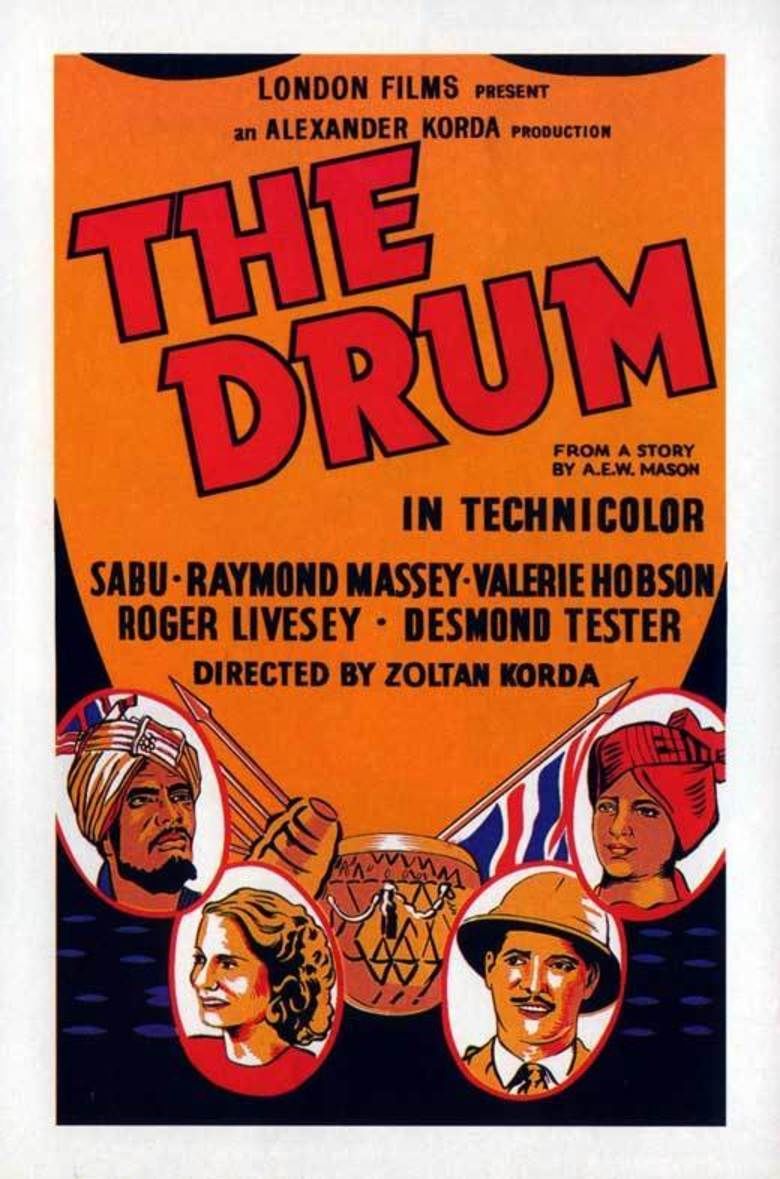The Drum (1938 film)
6.8 /10 1 Votes6.8
Music director John D. H. Greenwood Duration Country United Kingdom | 6.6/10 IMDb Genre Adventure, War Screenplay Hugh Gray | |||||||||||||||||||||||||||||||||
 | ||||||||||||||||||||||||||||||||||
Release date 1 April 1938 Cast Sabu (Prince Azim), (Prince Ghul), (Mrs. Carruthers), (Capt. Carruthers), (Lieut. Escott), (Bill Holder)Similar movies Mad Max: Fury Road , The Hunger Games: Mockingjay - Part 1 , Snowpiercer , Coming to America , The Rocker , White God | ||||||||||||||||||||||||||||||||||
The Drum (released in the U.S. as Drums) is a 1938 British Technicolor film from the book The Drum by A. E. W. Mason. The film is directed by Zoltan Korda and produced by Alexander Korda. It stars Sabu Dastagir, Raymond Massey, Roger Livesey and Valerie Hobson.
Contents

Korda’s company London Films made three films in the 1930s about the British Empire: Sanders of the River (1936), The Drum and The Four Feathers (1939). They are often known as the Empire trilogy, although they were not conceived as such.
Plot
During the British Raj, Captain Carruthers (Roger Livesey) works under cover to track smuggled shipments of arms on the restless Northwest Frontier of India, the modern day Pakistan-Afghanistan border. He fears a full-scale rebellion is brewing. To forestall this, the British governor (Francis L. Sullivan) signs a treaty with the friendly, peace-loving ruler of Tokot, a key kingdom in the region, which is described as four days' march northward from Peshawar. In real life the British held a fort at Abazai near this location, not far from the famous Takht Bhai ruins. Meanwhile, the king's son, Prince Azim (Sabu), befriends Carruthers and a British drummer boy, Bill Holder (Desmond Tester), who teaches him how to play the instrument.
However, the king's brother, Prince Ghul (Raymond Massey), has the king assassinated and usurps the throne; Azim escapes a similar fate thanks to two loyal retainers. They hide out in Peshawar, where the British are based. When one of Ghul's men finds and tries to kill the prince, Azim is rescued by Carruthers' wife (Valerie Hobson). Although he is offered sanctuary, Azim declines, believing it to be safer to remain hidden among his own people.
Carruthers is then sent to negotiate with Ghul, who pretends to want to honour the treaty. In reality, Ghul is the mastermind behind the rebellion. He plots to kill Carruthers and his detachment of men on the last day of a festival to signal the start of the revolt. Prince Azim learns of the ambush. When he is unable to convince the governor, he chooses to risk his own life to warn his friends. After Azim leaves for home, the governor receives confirmation of the plot and sends four battalions to the rescue.
Azim manages to warn Carruthers of the impending massacre by playing a danger signal on the "Sacred Drum of Tokot", saving many British lives. Ghul is killed in the ensuing battle and Azim is installed as his replacement.
Production
The Scottish regiment featured in this film is a battalion of the Gordon Highlanders, as evident from the cap badge, kilt and headdress. This is true to life, as the Gordon Highlanders were very active on the North-West Frontier during the British Raj, and were, for a time, garrisoned at Fort Jamrud at the mouth of the Khyber Pass. Portions of the film shot in India were filmed in Chitral and the North-West Frontier, and there are scenes very reminiscent of the Khyber Pass. However, some mountain scenes were also filmed in North Wales (Rhinog Fawr Mountain and Harlech).
One sequence shows an Indian Army gun crew unlimbering a mountain battery, a small field piece that was disassembled and transported on the backs of pack animals. Such guns were used frequently on the North-West Frontier, and a mountain battery from the Indian Army also was deployed with the ANZACs at Gallipoli, 1915-1916. Similarly, a muleback radio set is used in the opening skirmish scene. During an early scene with his courtiers, Prince Ghul says that he was an observer at Gallipoli, and that emulation of British training and tactics, not religious enthusiasm, will be the key to his own army's success.
Reception
The film was well received in Britain but caused protests when shown in Bombay and Madras, where it was considered by many to be British propaganda.
References
The Drum (1938 film) WikipediaThe Drum (1938 film) IMDb The Drum (1938 film) themoviedb.org
